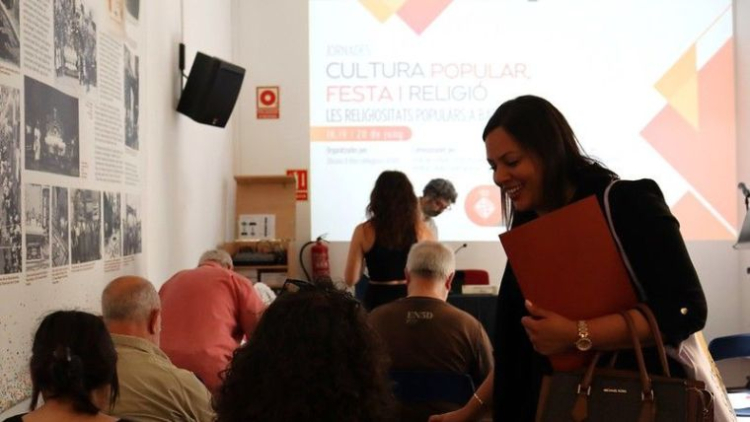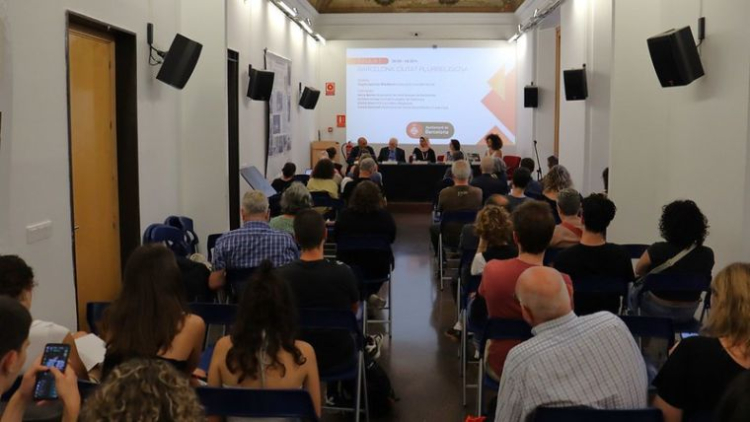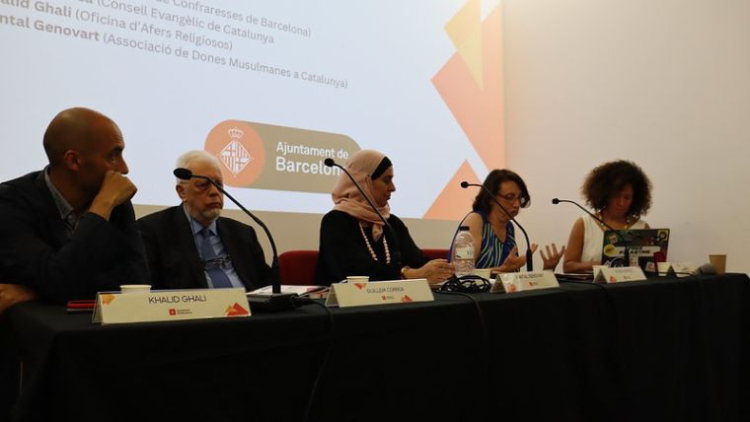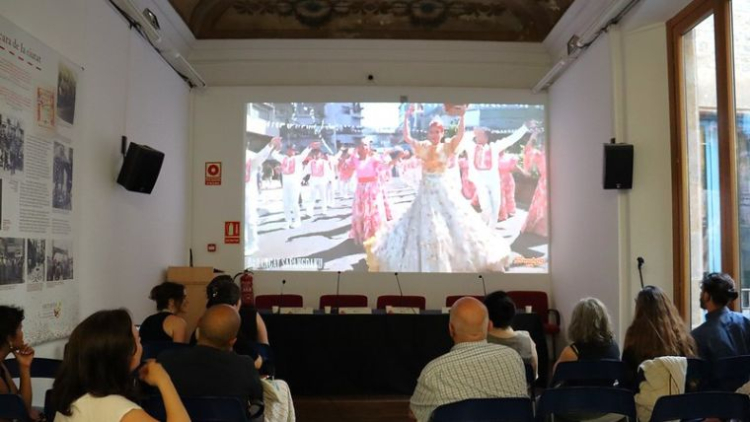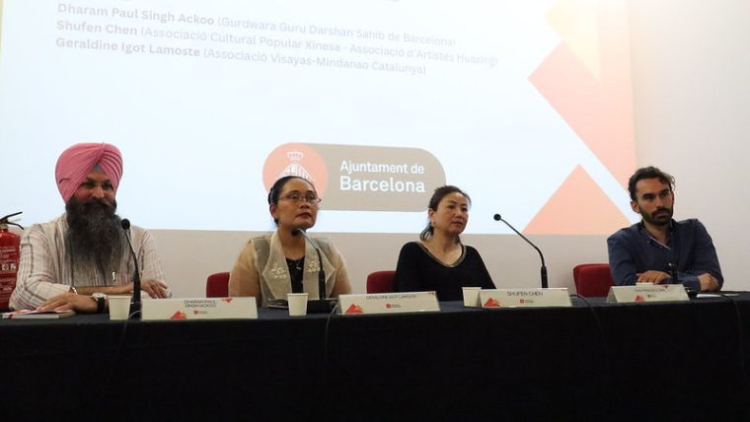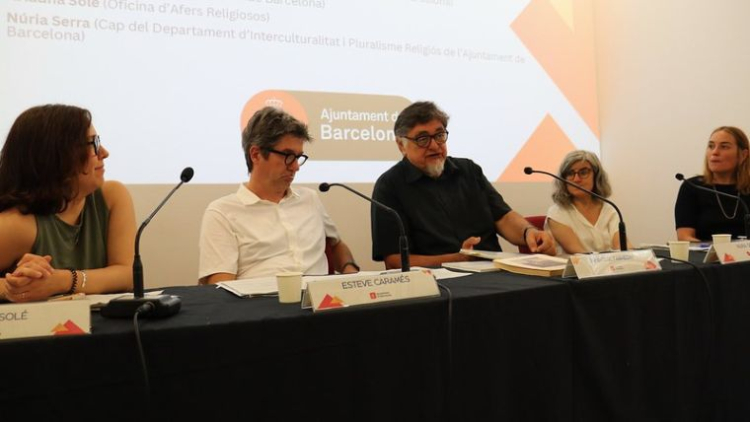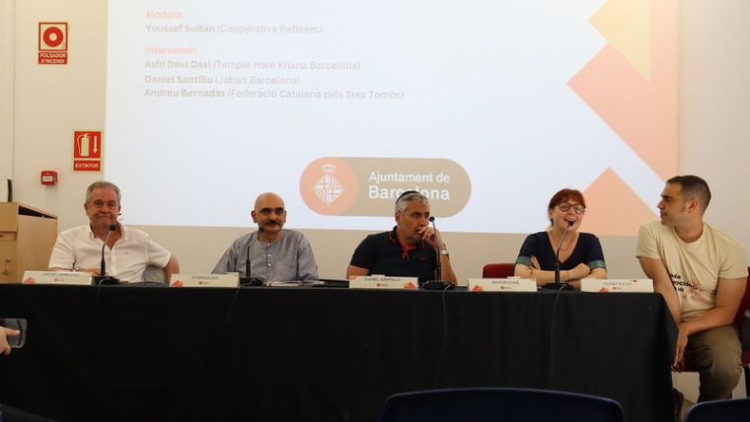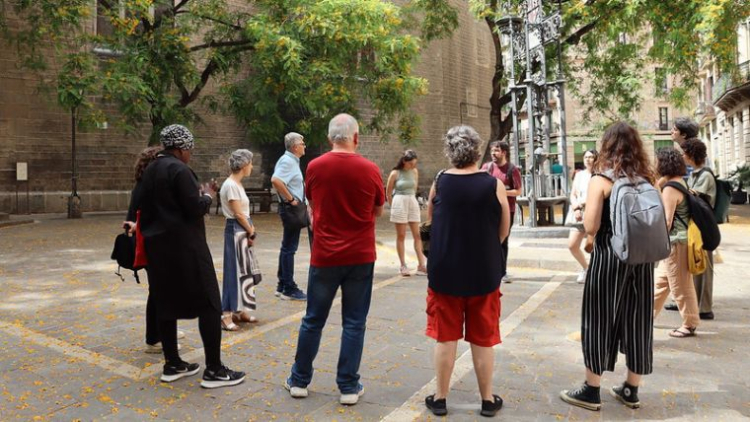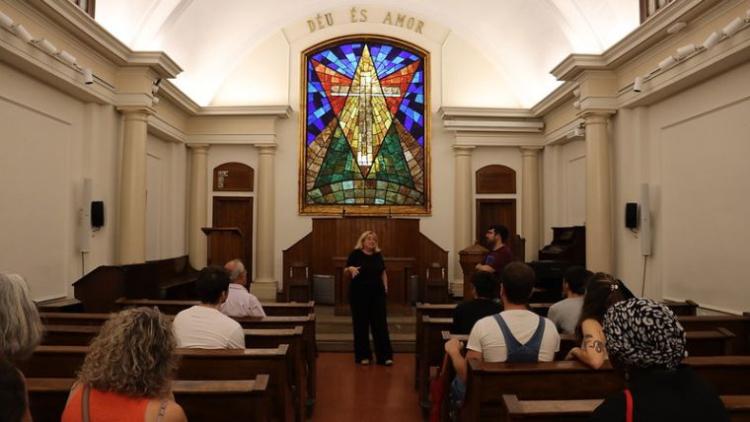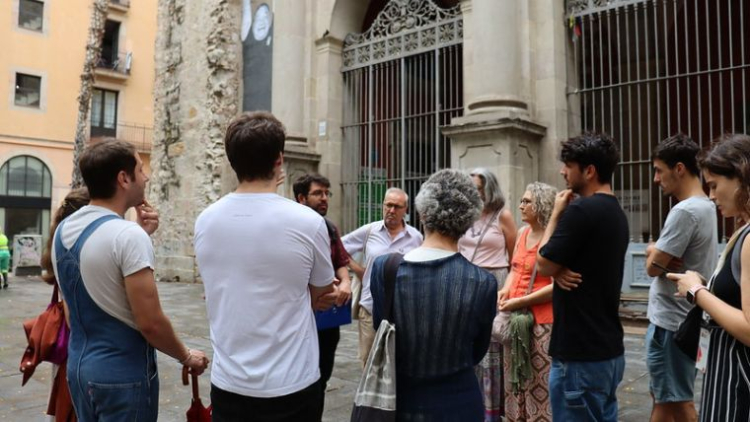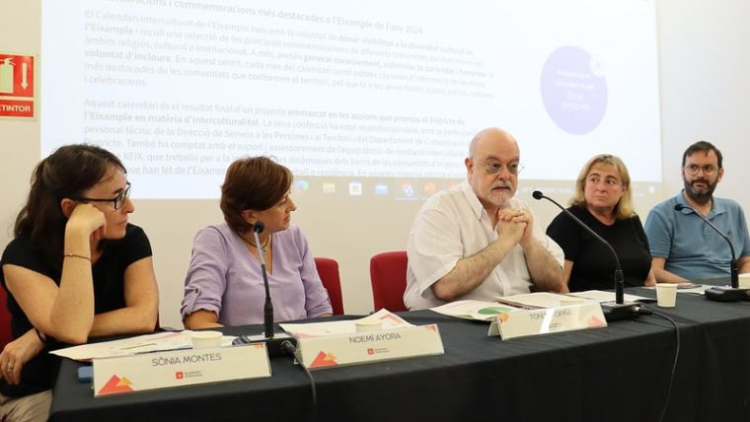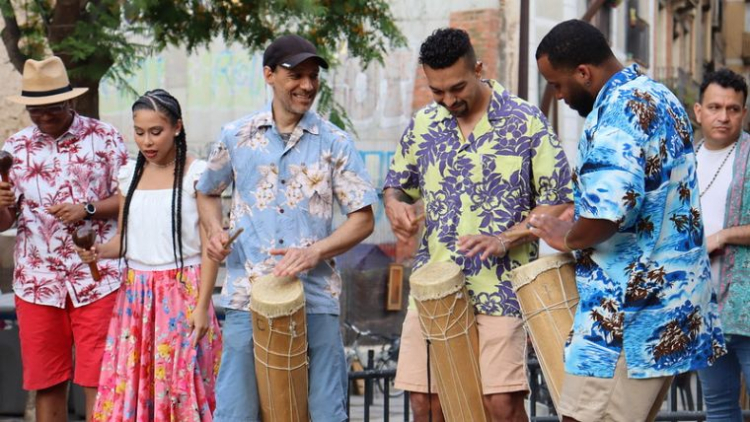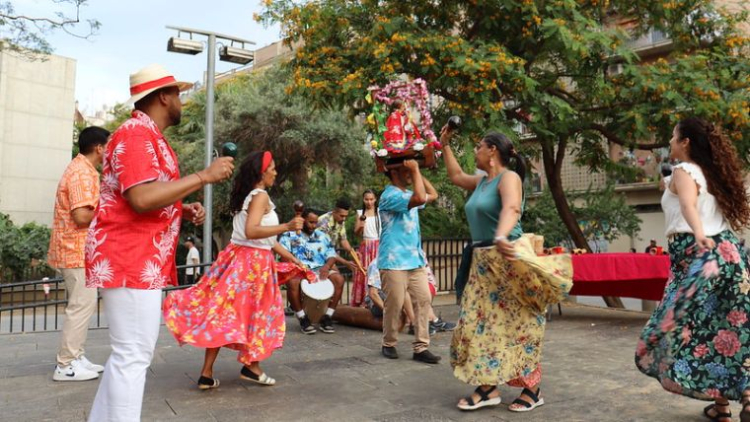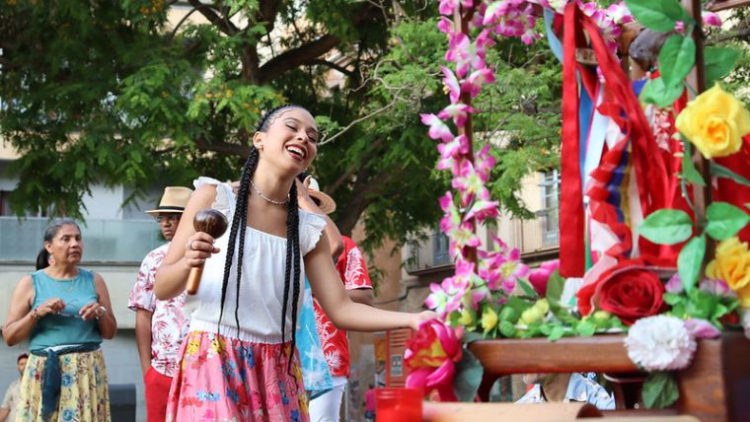“Living together leads to an intermingling of different identities and their transformation into popular culture”: Dvarka Das
La Casa dels Entremesos was the venue for the “Popular Culture, Festivals and Religion: Popular Religiosity in Barcelona” on 18, 19 and 20 June, organised by the Office of Religious Affairs (OAR) and curated by the work group Popular Culture and Conflict at the at the Institut Cultural Català d’Antropologia. A total of four round tables, a film forum and two routes took place within the framework of the conference, with the aim of reflecting on the city's cultural plurality and the ways in which this is expressed through public events and the religious and spiritual celebrations of the different communities.
Festivals are a polymorphic expression of a community’s identity. They are public celebrations with a strong ritual component. This is especially true in the case of festivals that are explicitly religious or spiritual. In Barcelona, the urban landscape reflects the very broad range of cultures, beliefs and religions of the inhabitants, and public spaces provide the setting for a huge diversity of festive events. This was the central theme of the conference “Popular Culture, Festivals and Religion: Popular Religiosity in Barcelona”, organised by the Office of Religious Affairs (OAR) and curated by the ICA’s Popular Culture and Conflict work group.
The conference took place at La Casa dels Entremesos, beginning on the afternoon of 18 June with a presentation by event host Salwa L’Aouaji El Gharbi, a legal expert on migration and diversity. The opening speech was delivered by Sara Belbeida Bedoui, Commissioner for Citizen Relations and Cultural and Religious Diversity at Barcelona City Council. Salwa L’Aouaji El Gharbi began by stressing the importance of holding a conference like this one that focuses on the diversity of the public celebrations that convey the beliefs and convictions of the communities that coexist in Barcelona. Sara Belbeida carried on with the institutional welcome, underlining the importance of popular celebrations in terms of identity, and the common, community based dimension that religions acquire through such celebrations: “‘Religious and cultural diversity is a treasure that reminds us of the beauty of the community in all its complexity”.
This was followed by the inaugural address “When God Comes to Barcelona to Celebrate” by Amadeu Carbó, where the folklorist discussed the festive aspect of popular religiosity that stems from tradition in Barcelona, in order to then consider the need to take a look at it with a critical eye, taking into account the reality of the city. Because although Barcelona’s festive calendar is based on the wholly Catholic foundations that in the past were shared by the local people, today, he said, “the profile of the population has changed considerably, and quite dramatically”. In this context, the city’s big annual festival, “the maximum expression of sociability, and of the sense of belonging to a society, city, neighbourhood or street” is a powerful way of communicating social reality, and it must be able to evolve in order to keep up with a changing world. “It’s already taken us rather too long to take note of the new festive realities that are emerging in the city as a result of Barcelona’s changing population profile, and this needs to be addressed with courage by the public authorities, from a perspective that aims to add, and never to subtract”, he said.
Amadeu Carbó’s lecture was accompanied by a discussion led by Maria Garganté, art historian and researcher in popular religiosity and cultural heritage. Like Carbó, Garganté stressed that religiosity permeates many areas of life, especially public life, where it becomes a communal expression of identity, but is at the same time a space where identities are dissolved.
Barcelona, a multi-religious city
The conference continued on 18 June with the first round table, entitled “Barcelona, a City of Many Religions”, moderated by Ángela Aparicio-Blackburn, founder of Cultura en Vivo Barcelona. Taking part were Núria Borraz, chair of the Confraresses de Barcelona Association, Guillem Correa, secretary general of the Evangelical Council of Catalonia (CEC) and member of the Estable de Religions work group; Khalid Ghali, coordinator at the OAR, and Xantal Genovart, from the Association of Muslim Women in Catalonia.
It constituted a space for reflection on the implications of religious plurality in the city, and the revival of public life by certain religious organisations within a changing urban reality. In fact, Núria Borraz began by stressing this shared component of identity, and highlighting the importance of recognising it as such through dialogue. A dialogue in which everyone needs to participate, including those who do not share dominant points of view. Xantal Genovart said that it is a matter of “getting to know each other by recognising each other”, and in this way advancing towards a normalisation that has already taken place in celebrations such as the public ‘iftars’ that are already being held in many of the city’s neighbourhoods, almost like a “sopar de germanor” [fellowship dinner].
Guillem Correa seconded this position, saying that this normalisation involves “not only setting down this equality on paper, but also taking specific steps to publicly acknowledge the different faiths”. Because as Khalid Ghali points out, “in Barcelona there are many public celebrations that are extremely diverse, and these are organised by people from Barcelona. ‘Strangerising’ them is a mistake”. However, Correa pointed out, the aim is to recognise not only plurality, but also singularity: “Working specifically on the narrative and the terminology, and moving towards a shared narrative”.
Visualising public celebrations: Cineforum
After the first round table, the first day of the conference concluded with a cineforum where representatives of different communities in the city presented audiovisual recordings of some of their public celebrations. The space was moderated by Juan Francisco Díaz, a PhD student from the Visual Trust project at the University of Barcelona (UB). This session was a space “to follow, through audiovisual media, the practices of the different communities in the city. Because they need to be made visible in order to be recognised”, as Díaz pointed out. The first video, presented by Shufen Chen, from the Associació Cultural Popular Xinesa [Chinese People’s Cultural Association] and the Huaxing Artist’s Association, was a snapshot of the Chinese New Year celebration that takes place in the Fort Pienc neighbourhood. You could see that it was not only Chinese organisations taking part, but also other associations and groups, sharing the kind of common and plural identity that was discussed at the first round table.
The next video, presented by Geraldine Lamoste from the Visayas-Mindanao Catalunya Association, also revealed the plural dynamics of public celebrations. It was a recording of the celebration of Sinulog, a Filipino festival commemorating the conversion of the Filipino people to Catholicism, which not only combines pre-Catholic traditions from the islands with Catholic faith, but is also a festival with deep roots in Barcelona. This was followed by a video compilation of different common, public spiritual practices within the Sikh community, presented by Dharam Paul Singh Ackoo of the Gurdwara Guru Darshan Sahib in Barcelona. To conclude the audiovisual presentations, Díaz showed a video recorded as part of the Visual Trust project in collaboration with the Barcelona International Society for Krishna Consciousness (ISKCON) which shows the celebration of the Ratha Yatra, a procession in honour of Jagannath, a representation of Krishna.
All were instances of the use of public space by minority faiths, which in turn create synergies with Barcelona’s dynamics. Of course, this is not something that happens without a degree of conflict. Laughing, Singh Ackoo explained that “when football’s on, the administration organises everything necessary for the safety of the celebration in a matter of hours, but it’s more difficult for us”. Culture clashes are also evident in these public celebrations, as Chen mentioned in the case of the Chinese New Year: “for us, the dragon is a very positive symbol, but for the Christian community it represents something evil”. However, Díaz concluded, this is a living process of communal adaptation between traditions and public space.
Moving Towards a New Festive Calendar
On the morning of 19 June, the second round table of the conference, entitled “Moving Towards a New Festive Calendar”, took place. Moderated by Romina Martínez, a member of the Popular Culture and Conflict work group at the Catalan Institute of Anthropology (ICA), it dealt with the perspectives and predictions that different areas of local public administration have on the appropriation of public space by religious events and how these are managed. Taking part were Núria Serra, head of the Department of Interculturality and Religious Pluralism at Barcelona City Council; Francesc Fabregat, head of popular culture at Barcelona City Council; Esteve Caramés, head of programmes at the Barcelona Institute of Culture (ICUB), and Ariadna Solé Arraràs, a technician at the OAR.
Francesc Fabregat began by presenting what is known as the “festive protocol”, which was introduced in Barcelona in 2008 and approved in 2011. The process of drawing up the protocol began in collaboration with a range of organisations, with the aim of “establishing a calendar of Barcelona’s own celebrations” that incorporates celebrations such as Santa Eulàlia, Corpus Christi and La Mercè. The protocol also defines popular culture as “that which a community considers to be its own”. At the same time, the administration began to introduce intercultural and inter-religious discourses, and there are many celebrations that take place outside this protocol, such as the Feria de Abril, as the speaker mentioned. Nevertheless, “the protocol is a living, dynamic agreement between the City Council and the people”, he said.
Esteve Caramés took over from Fabregat, talking about the festive calendar, pointing out that “we can’t decide which communities have a place and which don’t, they’re simply there, and diversity is not something to be decided upon, it’s a reality”. As Caramés maintained, Barcelona has its own popular culture, which must be preserved and made visible, but it is also an extremely diverse city. This is why he proposed “the construction of a festive calendar that’s independent of the protocol, one that includes all these riches, so that we can offer a plural vision of everything that happens in Barcelona”. To round off, Núria Serra offered a precise description of this cultural wealth: “According to the 2024 data, 33.6% of the people living in Barcelona were born in another country, and 180 different nationalities, around 300 languages and 36 faiths coexist in the city”. For this reason, Serra explained, years ago the City Council reached a consensus on adopting an intercultural perspective, which basically involves three principles: equality and non-discrimination, recognition of diversity and participation. “As a department, our job is to make this a reality, so that everyone can feel that the city is theirs”, he said.
The OAR is one of the organisations that was created with this goal in mind, and it follows precisely these three principles to guarantee the right to religious freedom, which is intrinsic to the adoption of an intercultural perspective. “Because”, explained Ariadna Solé, ‘the fact that the administration is non-denominational doesn’t mean that it can’t establish dialogues with different faiths. It’s a question of adding to, and adding value to, all popular culture regardless of to what degree it may be religious”.
Religious expression in public space
The next round table, entitled “Religious Expression in Public Space”, focused on the different uses that some religious communities make of urban space, and the adequacy of such uses in terms of the exercise of the right to religious freedom. It was moderated by Youssef Sultan, of the Cooperativa Reflexes, and taking part were Dvarka Das and Ashi Devi Dasi, members of the ISKCON Barcelona Hindu temple; Daniel Santillo, from the Jabad Barcelona Jewish community, and Andreu Bernadàs, chair of the Federació Catalana dels Tres Tombs.
The round table began with a definition of popular culture, and the place of spirituality. Andreu Bernadàs said that popular culture was a social construction, where “all colours are intermingled, and all spirituality, whether religious or secular, has a place”. Dvarka Das said that within this construction time plays a fundamental role: “Migration enriches the local culture; the fact of living together inevitably leads to the mixing of different identities, and their transformation into popular culture”. And that mixing only takes place in the public space, in the street. Because, said Daniel Santillo, “society doesn’t expect us to know about other peoples’ faiths, it expects them to be kept private; but taking religions out into the street means talking and coming to understand each other”.
However, sharing can only take place if “majority popular cultures”, as Youssef Sultan called them, are an open, inclusive space for cultural transformation and reconstruction. Ashi Devi Dasi pointed out that the obstacle lies not in the attitude of the majority culture, which is almost always welcoming, but in the stance taken by the authorities: “There is no rivalry with other religions, but it’s made easier for some faiths to be able to use public spaces, whereas our requests have been denied, which stops us from going out on to the street”. Andreu Bernadàs and Dvarka Das agreed with her: “Barcelona society takes on board everything that’s new and makes it its own. However, the authorities tend only to embrace the projects that interest them – for economic reasons, but also out of fear of the activity on the street, of the spontaneity of the celebrations that bring people together”, said Bernadàs. Dvarka Das, mentioned the case of the Ratha Yatra celebration: “We’ve been celebrating Ratha Yatra for 31 years, and people actively participate, they appreciate the shows, our exhibitions and traditions, so much so that I’d say that it is indeed an undeniable part of Barcelona’s culture. And yes, it’s held with the collaboration of the City Council, but that doesn’t mean that we don’t meet any obstacles when it comes to getting permission”. On the other hand, Daniel Santillo said that he had not faced these types of obstacles: “We’ve been organising activities in Plaça Sant Jaume for more than 13 years, and I’ve never felt any pressure or met with any barriers. We don’t do too many public activities either, but my children have had their exams moved because of Jewish holidays for example. I believe that there’s a ‘normality’ within public space”.
And Meetings in that public space play an essential role in making a religiously diverse popular culture visible, doing what the media – which often tends to dismiss both popular culture and religion – should be doing: “The media see religion as something fanatical, but the streets normalise it: we all meet, we respect each other, we recognise each other, and we recognise the diversity of our identities”, said Santillo. “The media tend to be somewhat repetitive, and this is a tendency that needs to be mitigated”, added Bernadàs. To overcome this, concluded Dvarka Das, “an understanding of the responsibility shared by religious communities, the media and the administration is needed”.
Routes: urban space and religions
Two routes took place on the afternoon of 19 June, “El Born, Santa Caterina i Sant Pere”, and “El Raval”, both aimed at exemplifying how urban transformation and religious diversity interact in each of these neighbourhoods. Both were led by Víctor Albert-Blanco, a doctor and a member of ISOR (Research in the Sociology of Religion).
The first route began at La Casa dels Entremesos, where Albert described Barcelona’s multi-religious character as endemic, and noted that it has diversified in recent years as a result of increased migration: “The very fabric of the city is based on this diversity”. The first stop was the Plaça de Sant Pere, which revealed the role of the monasteries and convents in shaping the city’s urban expansion. Albert then led the group along C/ Sant Pere Mitjà to see the façade of the Al Qaim Islamic Centre, the only Shiite centre in the city. Albert explained that it was “representative of the Muslim spaces in the city, which tend to be workshops or converted shops, so they’re small, precarious spaces in physical terms”. The last stop was the Plaça Pou de la Figuera, a “witness to the urban transformation of the 1990s”, and the Assafa Muslim Community, who invited the group to go in for a visit.
The second route started out from Plaça Vicenç Martorell, where Albert-Blanco explained the key details regarding the construction of the Raval neighbourhood, between the second and third city walls. In medieval times it was very much organised around the religious buildings, and then restructured in the modern industrialised era, due to the disentailments and the struggle for urban space. The first place of worship to be visited was the Barcelona Centro Protestant Church, in the middle of C/ Tallers. The church was founded in 1869 in a different location, and the pastor explained that the current building follows the guidelines of the Law of Religious Freedom passed in 1967, during the Franco dictatorship: “The church itself is down a long corridor, and so a long way away from the door. This is because they wanted to stop anyone who was walking by from seeing what was inside”. The next stop was the Plaça de Sant Agustí and the Sant Agustí parish church, which was built in 1728 as an Augustinian convent, and is today one of the most important meeting points for Barcelona’s Filipino community, which celebrates festivals such as the Sinulog. The route ended with a visit to the Tariq Bin Ziyad mosque, in C/ Sant Rafael, which has the same features as the one included on the first route.
Experiences along the Road to an Intercultural Festive Calendar
The final round table of the conference, “Experiences along the Road to an Intercultural Festive Calendar”, was a space where different social and municipal organisations presented their own cultural and religious diversity initiatives in their areas of the city. The exchange session was moderated by Laura Villaplana, a technician from the BCN Interculturality Programme, with the participation of Marta López, a member of the Raval Interreligious Group (GIR) at the Tot Raval Foundation; Sergio Arévalo, from the UNESCO Association for Interreligious Dialogue (AUDIR); Toni Estopiñà, an interculturality technician from the Eixample district, and Noemí Ayora and Sònia Montes, technicians from the Nou Barris district.
Sergio Arévalo began by presenting AUDIR as a “multi-convictional but secular” association, where “religion is understood as culture – not only in terms of its art, but as a whole, including spirituality and beliefs”. In this sense, it is also part of the heritage of all humanity, because “beliefs and celebrations are sources of knowledge and recognition”. In order to move towards this recognition, AUDIR wants to make religious plurality visible, which it does primarily by means of two main tools: its Interreligious and Interconvictional Calendar and a didactic guide for secondary schools that describes different religious traditions, their festivals and some of the remarkable aspects of each.
Marta López then introduced the GIR and its calendar of celebrations: “The GIR is a group that seeks knowledge of the ‘other’ in a neighbourhood setting, and so the calendar seeks a ‘us’ that is extremely diverse, which is what characterises the neighbourhood”. This year’s edition is the thirteenth, and as always, there are a mix of cultural, religious and socio-political festivities. “They’re all equally important, because celebrating together and becoming an ‘us’ is always the goal”. Afterwards, Toni Estopiñà presented the Eixample district’s intercultural calendar, something that he explained “came from above, because we don’t have many associations as such in the Eixample district, and there’s very little interaction with those that do exist. Nonetheless it was built cooperatively, by the administration and associations”.
Noemí Ayora and Sònia Montes, technicians from the Nou Barris district, rounded things off by sharing experiences “that might perhaps lead us to the construction of a more diverse festive calendar, because we don’t yet have one”, explained Montes. No less than 138 foreign communities and seven religious faiths co-exist in the Nou Barris district, where 21.5% of the inhabitants do not have Spanish nationality. The aim of the initiatives would be to give recognition to all these communities and traditions, “by working collectively with them”, said Ayora.
Wrap up and the closing verbena
The conference closed with a few words from Manuel Delgado, member and coordinator of the ICA’s Popular Culture and Conflict work group. He highlighted the complexity of the concepts that underpinned the conference. “Is it spiritual to head to Montserrat once a month to look for UFOs, in the hope of seeing something that’s never been seen before? And what about the 15+1 procession in L’Hospitalet de Llobregat, a secular religious procession?” he asked, going on to say that “the difference between what is religious and what is not, is complex, and difficult to establish”. For this reason, Delgado argued that “we need to approach religious phenomena as what they actually are, social or cultural phenomena – just another form of ideology if you like” – while always being strongly aware of the issue of diversity, because “diversity often hides inequality”, insofar as it is marked by a “hegemonic ideological order that establishes that the only appropriate way of thinking is enlightened rationality”, which implicitly relegates what does not fall into this category as “inferior forms of culture”.
Finally, the conference was brought to a close with a drumming exhibition by Tambores de San Juan in Plaça Pou de la Figuera organised by the Cultura Contraseñae de Danza Venezolana Association, accompanied by coca and Cava, openly and publicly putting into practice what had been discussed in the previous activities.

